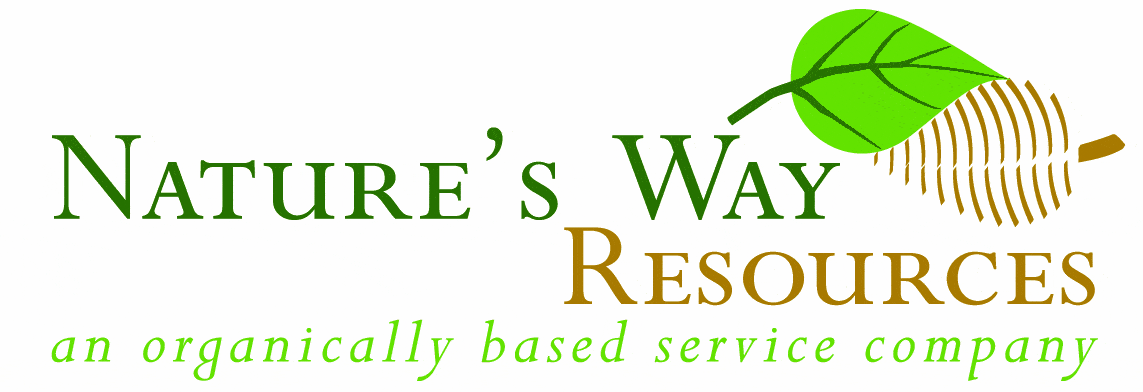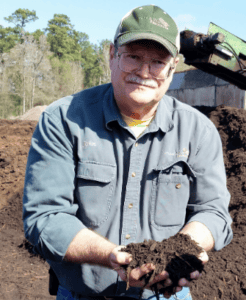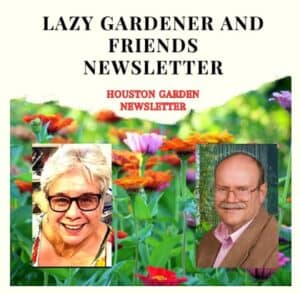 Nature’s Way Resources is proud to produce & email you this free weekly newsletter. We have no ads, but sponsors do graciously help support this project as a public service. Please note their names below & show your gratitude for this free service by patronizing their businesses! To become a sponsor, call (936) 273-1200
Nature’s Way Resources is proud to produce & email you this free weekly newsletter. We have no ads, but sponsors do graciously help support this project as a public service. Please note their names below & show your gratitude for this free service by patronizing their businesses! To become a sponsor, call (936) 273-1200
Nature’s Way Resources owner John Ferguson, “The Lazy Gardener” Brenda Beust Smith and Pablo Hernandez welcome your feedback and are so grateful to the many horticulturists who contribute their expertise
Click here to join our email list
CLICK HERE for PDFs OF PAST LG&F NEWSLETTERS
 “My yard is not the beautiful landscape some may think. It’s a “lazy gardener’s garden” — more of what Felder Rushing, in “Maverick Gardeners,” describes as everyday folks who cultivate their yards with passion and ‘unique’ techniques.” See below! BBS — Felder’s Blog
“My yard is not the beautiful landscape some may think. It’s a “lazy gardener’s garden” — more of what Felder Rushing, in “Maverick Gardeners,” describes as everyday folks who cultivate their yards with passion and ‘unique’ techniques.” See below! BBS — Felder’s Blog
DECADES AGO, someone asked me what do I mean by a “Lazy Gardener” ?Sort of an oxymoron? Not being a serious gardener then (or now), I said if I did what experts say to do and a plant dies, obviously it’s NOT my kind of plant. Reporter as I was back then, I tried to think of important points to save me time, energy and money but still produce an acceptable, low-care garden. Below, from my “Lazy Gardener’s Guide,” what I learned.
BY BRENDA BEUST SMITH
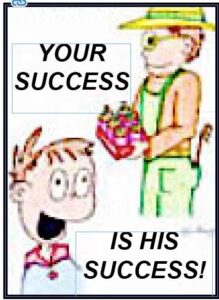 I. Thou shall appreciate the Upper Texas Gulf Coast’s unique subtropical ecology with often extreme weather changes and shall follow LOCAL gardening advice — not that for Texas in general or, worse, for national audiences
I. Thou shall appreciate the Upper Texas Gulf Coast’s unique subtropical ecology with often extreme weather changes and shall follow LOCAL gardening advice — not that for Texas in general or, worse, for national audiences
II. Thou shall not insist on growing “northern” plants in the middle of the Gulf Coast’s tropical summer.
III. Thou shall get to know thy neighborhood nurseryman.
IV. Thou shall learn sun and drainage requirements of plants BEFORE planting them in the ground.
V. Thou shall put plants requiring “normal” to “excellent” drainage in beds raised at least eight to ten inches above ground level . . . especially natives from Central/West Texas & Mexico
VI. Tho u shall mulch well all beds. ALL beds do better with mulch. Our winters have gotten so much colder, summers hotter. A healthy, ORGANIC mulch is well worth the effort.
u shall mulch well all beds. ALL beds do better with mulch. Our winters have gotten so much colder, summers hotter. A healthy, ORGANIC mulch is well worth the effort.
VII. Thou shall focus more on healthy soil and strong root growth than on what is going on above ground.
VIII. Thou shall not treat for insect or disease problems.Thou shall remove plants with unacceptable insect/disease damage and replace them with plants that don’t have unacceptable insect/disease problems in your area! (Remember, talking LAZY gardeners here.)
IX. Thou shall NOT allow fertilizers and other landscape treatments from your yard to drain into sewers or ditches where they contribute to flooding and other problems.
X. Thou shall, above all, have FUN! It’s YOUR garden. It needn’t be a mirror image of other gardens around you.It should be what YOU want and it should make YOU happy!

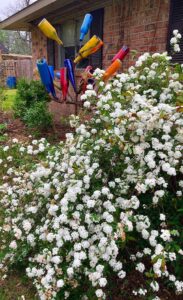 MY FAVORITE EARLY-BLOOMING PLANT Spiraea prunifolia, a native of Eastern Asia (they think, iso old no one knows for sure), has masses and masses of delicate white flower clusters, (ideal for “bridal wreaths)! Graceful arching branches and profusion of flowers bring a touch of classic beauty to gardens, whether as a stand-alone specimen, a focal point in mixed borders, as a backdrop for other flowering shrubs, hedge borders or mixed in with azaleas. Long-lived plants. Prune ONLY immediately after blooming. Like azaleas, after only a brief rest, they start producing buds for next year’s blooms!
MY FAVORITE EARLY-BLOOMING PLANT Spiraea prunifolia, a native of Eastern Asia (they think, iso old no one knows for sure), has masses and masses of delicate white flower clusters, (ideal for “bridal wreaths)! Graceful arching branches and profusion of flowers bring a touch of classic beauty to gardens, whether as a stand-alone specimen, a focal point in mixed borders, as a backdrop for other flowering shrubs, hedge borders or mixed in with azaleas. Long-lived plants. Prune ONLY immediately after blooming. Like azaleas, after only a brief rest, they start producing buds for next year’s blooms!
 KEEP A CLOSE EYE ON TREES! SIGNS TIME TO CHECK WITH TREE EXPERTS . . .
KEEP A CLOSE EYE ON TREES! SIGNS TIME TO CHECK WITH TREE EXPERTS . . .
- Cracks in trunk or peeling bark (pictured)
- Mushrooms growing near tree roots or base of trunk
- Multiple branches that have no living buds
- Sticks/bark on ground
- Leaning over
- Open Wounds
We’ve just been through a blistering hot summer, prolonged drought, vicious hurricane, unusual cold, snow and ice and more. Hat’s off to trees that survived Beryl’s 80-90 mph winds. SEVEN of our all-seriously tall trees didn’t survive (including a pine that fell on part of house).
Grateful for those still standing but no guarantee they didn’t suffered enough internal damage to demand close watching from now on. My joy at seeing green leaves sprouting from the remaining trees is tempered by the knowledge that results of tree trauma can take years to become obvious! Dying trees can and will produce new green leaves. Only time will tell, but please, keep an eye on yours! Texas A&M’s list of danger signs in your trees
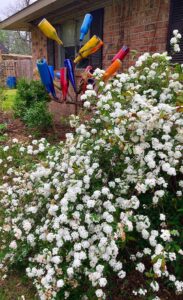 AFTER BERLE WIPED OUT SO MANY OF OUR TREES, hopes were not high for my usually gorgeous Bridal Wreath, so named for obvious reasons throughout history in many cultures. She has good reason to dread winter. Unexpected temperature fluctuations can damage buds, disrupting dormancy. But she’s one tough broad with her whimsical white reflective glow, especially in a full moon. About only way you can make her mad is to prune anytime except right after she blooms. She immediately starts setting buds for next spring. Pruning too late may stop that! She may be old (records date WAY BACK). But she still marches to her own drummer!
AFTER BERLE WIPED OUT SO MANY OF OUR TREES, hopes were not high for my usually gorgeous Bridal Wreath, so named for obvious reasons throughout history in many cultures. She has good reason to dread winter. Unexpected temperature fluctuations can damage buds, disrupting dormancy. But she’s one tough broad with her whimsical white reflective glow, especially in a full moon. About only way you can make her mad is to prune anytime except right after she blooms. She immediately starts setting buds for next spring. Pruning too late may stop that! She may be old (records date WAY BACK). But she still marches to her own drummer!
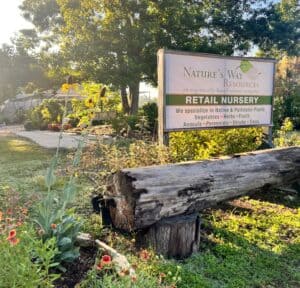 ATTN. GARDEN/PLANT GROUPS — Nature’s Way Resources offers free guided tours of NWR’s extensive nursery/soil/mulch facilities for garden clubs, plant societies and other plant-oriented, organized groups. As usual, NWR’s now-expanded meeting site is free to above groups. Reservations a must for both. Great time to visit!
ATTN. GARDEN/PLANT GROUPS — Nature’s Way Resources offers free guided tours of NWR’s extensive nursery/soil/mulch facilities for garden clubs, plant societies and other plant-oriented, organized groups. As usual, NWR’s now-expanded meeting site is free to above groups. Reservations a must for both. Great time to visit!
- SUBMITTING CALENDAR EVENTS?: These will be in next upcoming newsletter ONLY IF SUBMITTED IN OUR EXACT FORMAT they may be held until can be reformatted.
John’s Corner
NEWS FROM THE WONDERFUL WORLD
OF SOIL AND PLANTS
Subject: Prescribed fire GRAS glyphosate & dementia fungi mutualism
We have all seen on the news pictures of wildfires from Texas to California that caused billions of dollars in damage. This was caused by mismanagement of our land. In nature flammable fuel is not allowed to build up as small fires would occur every 2-3 years removing the fuel and revitalizing the ecosystem.
Today we can copy nature by using prescribed burns to prevent wildfires and restore the natural environment. The link below is a short video on how beneficial controlled burns (prescribed fire) is to restoring our land. Texas and Oklahoma fire experts created this video and gives an introduction to all sides of Prescribed Fire.
The USDA and FDA, etc. often uses a term called GRAS (Generally Recognized As Safe), which means they do not test foods for safety and just assume a food is safe to eat. Another way of stating it is that the food is substantially equivalent to the natural food.
It is used by many companies to describe a category of food substances that are not subject to premarket approval by the FDA and allows for its distribution without any safety testing.
For example, genetically modified soy plants were given the GRAS label and used all over the world and we were told that they were safe. Research is now showing that GM soybean oil damages the liver and kidneys in animal studies providing proof that it is not substantially equivalent. The researchers also found that urea and triglycerides were significantly higher in GM fed rats. They found it only took 90 days for significant damage to occur.
Open Access: Taheri H, Mesgari-Abbasi M, Khordadmehr M, Rahimi Mamaghani A, Abbasalizad-Farhangi M. Effect of genetically modified soybean oil consumption on biochemical and histological changes of liver and kidney in rats. Int J Drug Res Clin. 2024; 2: e11. doi: 10.34172/ijdrc.2024.e11. https://ijdrug.com/Article/ijdrc-3048
Have you ever wondered why we are so sick as a society in the USA? Over 90% of the soy-based products sold are GMO varieties. The reason for purchasing organic foods continues to grow.
Note: The new leadership team at the Department of Health and Human Services (HHS) has identified over 3,000 substances the FDA allowed to be dumped into our food supply under the GRASS label. Many or most of these are linked to the numerous health problems we see in society today.
A report in the Journal of Neuroinflammation (2024) found that exposure to the herbicide glyphosate found in products like Round Up, is pro-inflammatory. “Glyphosate exposure exacerbates neuroinflammation and Alzheimer’s disease like pathology despite a six-month recovery period in mice.”
The bottom line is that “glyphosate exposure serves as an accelerant of Alzheimer’s pathogenesis…”
Most cereal grains from wheat to rye (over 90%) are sprayed with glyphosate to kill the plants so they dry quicker and evenly making them easier to harvest. Hence, unless one buys organic, the breads and cereals you are consuming, contain glyphosate.
Researchers at the University of Maryland have found that when two separate species of fungi are found in the soil, they work together to protect plants from damaging abiotic stresses like drought or poor nutrients and harmful insects. Together they will parasitize bad insects and kill them but not by themselves. Journal PLOS Pathogens (2024)
If one uses a fungicide, they lose this benefit that explains why those using organic methods, have less insect issues.
SPONSORSHIP
If you are interested in becoming a sponsor, please contact us at 936-273-1200 or send an e-mail to: lazygardenerandfriends@gmail.com
ABOUT US
BRENDA BEUST SMITH WE KNOW HER BEST AS THE LAZY GARDENER . . .
- but Brenda Beust Smith is also:
- a national award-winning writer & editor
- a nationally-published writer & photographer
- a national horticultural speaker
- a former Houston Chronicle reporter
When the Chronicle discontinued Brenda’s 45-year-old Lazy Gardener” print column — started in the early ’70s as a fun side-project to reporting, it then ranked as the longestrunning, continuously-published local newspaper column in the Greater Houston area. The name, she says, is not just fun, it’s true.
Brenda’s gradual sideways step from reporter into gardening writing led first to an 18-year series of when-to-do-what Lazy Gardener Calendars, then to her Lazy Gardener’s Guide book which morphed into her Lazy Gardener’s Guide on CD, which she now emails free upon request.
Brenda became a Harris County Master Gardener and, over the years, served on theboards of many Greater Houston area horticulture organizations. She hosted local radio and TV shows, most notably a 10+-year Lazy Gardener specialty shows on HoustonPBS (Ch. 8) and her call-in “EcoGardening” show on KPFT-FM.
For over three decades, Brenda served as Assistant Production Manager of the GARDEN CLUB OF AMERICA’S “BULLETIN” magazine. Although still an active broad-based freelance writer, Brenda’s main focus now is THE LAZY GARDENER & FRIENDS HOUSTON GARDEN NEWSLETTER with John Ferguson and Pablo Hernandez of Nature’s Way Resources.
A native of New Orleans and graduate of St. Agnes Academy and the University of Houston, Brenda lives in Humble, TX, and is married to the retired Aldine High School Coach Bill Smith. They have one son, Blake.
Regarding this newsletter, Brenda is the lead writer, originator of it and the daily inspiration for it. We so appreciate the way she has made gardening such a fun way to celebrate life together for such a long time.
About her column, Brenda says: “I don’t consider myself a ‘garden writer.” I started out 50+ years ago as a very lazy “gardening reporter.” I still feel that way today. I hope my columns inspire/help newcomers, but I do not write to them. I write to very experienced gardeners who want to expand their horizons.
JOHN FERGUSON
John is a native Houstonian and has over 35 years of business experience. He owns Nature’s Way Resources, a composting company that specializes in high quality compost, mulch, and soil mixes. He holds a MS degree in Physics and Geology and is a licensed Soil Scientist in Texas.
John has won many awards in horticulture and environmental issues. For years he represented the composting industry on the Houston-Galveston Area Council for solid waste. His personal garden has been featured in several horticultural books and “Better Homes and Gardens” magazine. His business has been recognized in the Wall Street Journal for the quality and value of their products. He is a member of the Physics Honor Society and many other professional societies. John is the co-author of the book Organic Management for the Professional.
For this newsletter, John contributes articles regularly and is responsible for publishing it.
PABLO HERNANDEZ Pablo Hernandez is the special projects coordinator for Nature’s Way Resources. His realm of responsibilities include: serving as a webmaster, IT support, technical problem solving/troubleshooting, metrics management and quality control. Pablo helps this newsletter happen from a technical support standpoint.
Download the Newsletter with Our Events Calendar Below!
